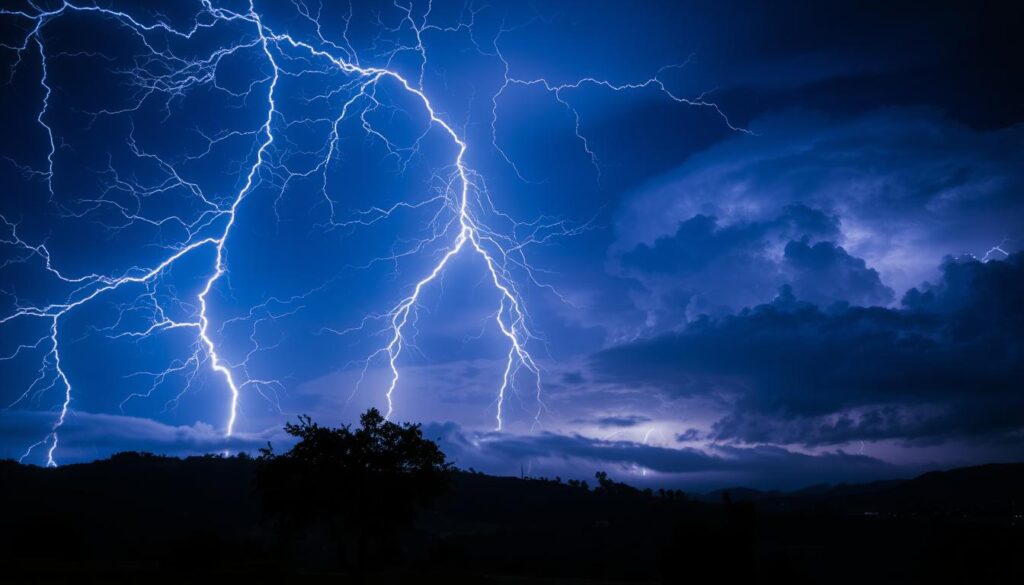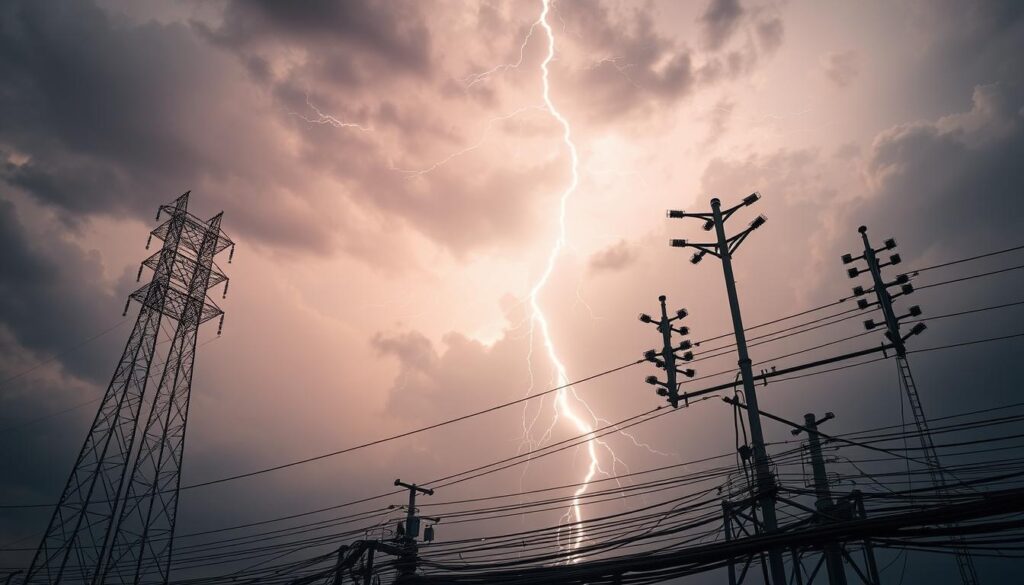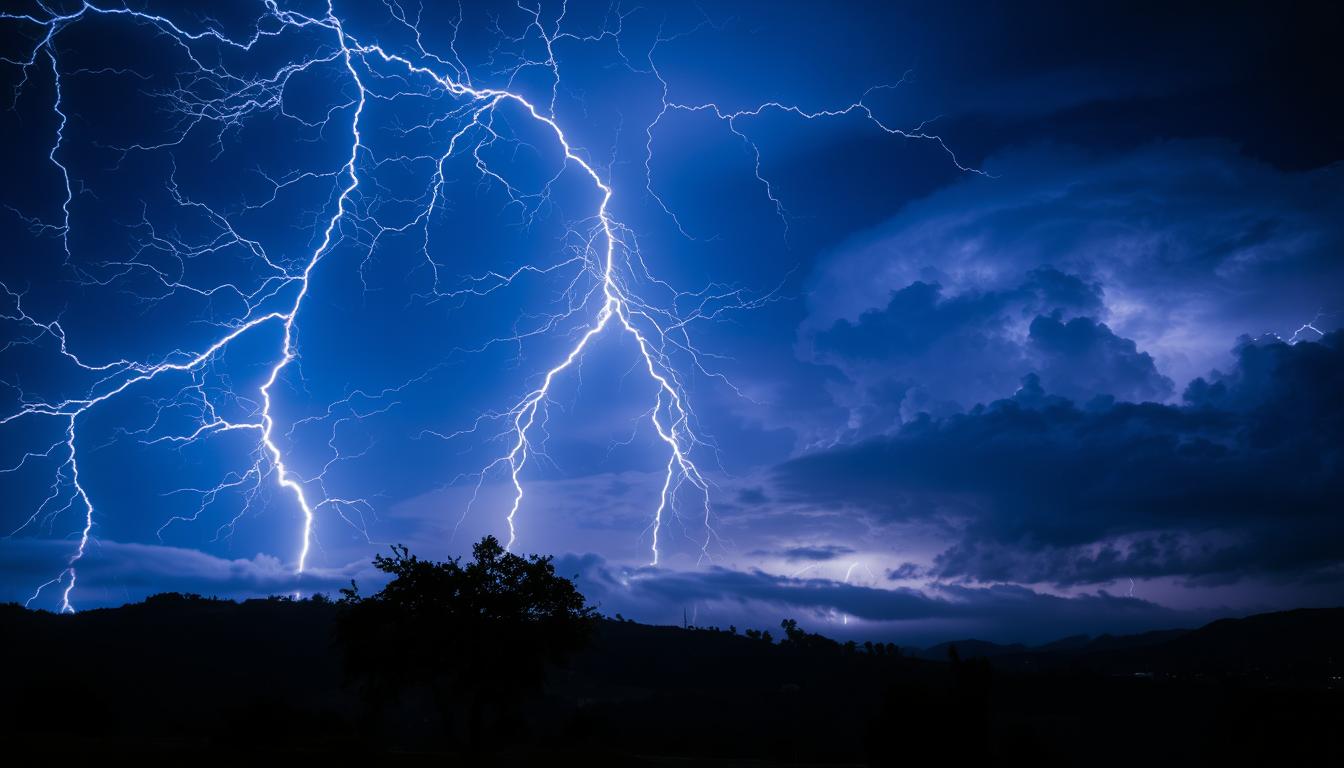Lightning Strikes the Same Spots are really interesting and have made many people curious. Thunderstorms and lightning strikes are complex. They involve many factors. Knowing about lightning strike patterns and thunderstorm formation helps us understand why lightning hits the same spot so often.

Studying lightning strike patterns and thunderstorm formation has helped us learn a lot. By looking into what causes lightning strikes, we can see how complex they are. In this article, we’ll explore lightning strike patterns and thunderstorm formation. We’ll look at how geography and climate change affect these events.
Key Takeaways Lightning Strikes the Same Spot
- Lightning strike patterns are influenced by thunderstorm formation and geographical features.
- Understanding lightning strike patterns is crucial to predicting and preparing for lightning strikes.
- Thunderstorm formation is a complex process that involves various atmospheric factors.
- Climate change is impacting lightning strike patterns and frequencies.
- Lightning strike patterns can be studied to improve our understanding of this natural phenomenon.
Understanding the Basics of Lightning Formation
Lightning formation is a complex process tied to the electric nature of thunderstorms. To understand how lightning forms, we must explore thunderstorm dynamics. Studies on thunderstorm dynamics and lightning creation reveal the steps to lightning formation. The electric nature of thunderstorms involves the separation of electrical charges in the cloud, leading to the discharge of electricity, known as lightning, Lightning Strikes the Same Spot.
A crucial part of lightning formation is the creation of lightning paths. These paths are formed when a channel of ionized air, called a leader, extends from the cloud to the ground. The leader is drawn to the ground, creating a conductive path for the lightning. This process is shaped by the electric nature of thunderstorms and the environment, Lightning Strikes the Same Spot.
There are different types of lightning strikes, like intracloud, cloud-to-cloud, and cloud-to-ground lightning. Each type has unique characteristics, influenced by the electric nature of thunderstorms and the environment. Knowing the basics of lightning formation helps us appreciate the complexity of lightning and its behavior, Lightning Strikes the Same Spot.
Why Lightning Strikes the Same Spot Hundreds of Times: The Scientific Explanation
Lightning striking the same spot over and over is due to lightning strike patterns and a scientific explanation. Research shows that some places get hit more because of their location and the air around them, Lightning Strikes the Same Spot.
Things like tall mountains or buildings can make a spot more likely to get hit. The ground’s ability to conduct electricity also plays a role. These factors help explain why some areas get hit by lightning more than others. The science behind lightning formation and how electrical charges move in the air is key to understanding this.
Climate change also affects lightning strike patterns. It can change the air and lead to more lightning. Knowing the science behind lightning strikes helps us make better protection systems. This reduces the dangers lightning poses, Lightning Strikes the Same Spot.
Some main reasons for repeated lightning strikes include:
- Geographical features, such as mountains or hills
- Atmospheric conditions, such as humidity and temperature
- Terrain conductivity, such as the presence of water or metal
The Role of Geographical Features in Lightning Strikes
Geographical factors greatly influence the chance of lightning strikes. The landscape’s unique features can make a region more prone to lightning. For example, mountains or hills can attract lightning because of their height. Also, tall buildings or towers can draw lightning towards them, acting as lightning rods.
Natural lightning rods, like tall trees or metal fences, also play a role. The type of soil and rock beneath the surface can affect lightning strike chances.
High Points and Tall Structures
- Mountains and hills can increase the likelihood of lightning strikes
- Tall structures, such as skyscrapers or towers, can act as lightning rods
- Natural lightning rods, like tall trees or metal fences, can contribute to the frequency of lightning strikes
Natural Lightning Rods Lightning Strikes the Same Spot
Natural lightning rods, such as tall trees or metal fences, can increase the likelihood of a lightning strike. These objects can conduct electricity and provide a path for lightning to follow, making them more susceptible to lightning strikes.
Terrain Conductivity Factors Lightning Strikes the Same Spot
Terrain conductivity factors, including the type of soil and underlying rock, can also affect the likelihood of a lightning strike. Areas with high conductivity, such as those with moist soil or underlying rock, can increase the chances of a lightning strike.
Famous Locations Repeatedly Struck by Lightning
There are many famous lightning strike locations around the world. These places get hit by lightning a lot because of their unique geography and climate. The Empire State Building in New York City, the Eiffel Tower in Paris, and the CN Tower in Toronto are some of these spots.
These landmarks are not just famous. They are also natural lightning rods. This means they attract lightning because of their height and location. For example, the Empire State Building gets hit by lightning about 25 times a year.
Other famous places include the Grand Canyon, the Rocky Mountains, and the Great Plains in the United States, Lightning Strikes the Same Spot.
Several factors make these places more likely to get hit by lightning. These include:
- Geography: Mountains, hills, and tall structures can attract lightning strikes
- Climate: Areas with lots of thunderstorms are more likely to get hit by lightning
- Location: Being close to big bodies of water or other weather patterns also increases the chance of lightning strikes
Knowing these factors helps us understand why some places get hit by lightning a lot. By studying these locations, we learn more about lightning and how it affects our world, Lightning Strikes the Same Spot.
The Empire State Building Case Study
The Empire State Building is a famous skyscraper in New York City. It has been hit by lightning many times. This shows how important lightning protection systems are.
Some key features of the Empire State Building’s design and lightning protection systems include:
- Lightning rods and air terminals to attract lightning and direct it harmlessly into the ground
- A network of down conductors to carry electrical currents from the lightning rods to the ground
- Grounding systems to dissipate electrical currents and prevent damage to the building’s foundation
Historical lightning events have shown that the Empire State Building’s lightning protection systems are effective. For example, during a severe thunderstorm in 2013, the building was struck by lightning several times. But the lightning protection systems worked well, preventing any significant damage, Lightning Strikes the Same Spot.
Annual Strike Statistics Lightning Strikes the Same Spot
The Empire State Building is struck by lightning on average around 25 times per year. This highlights the need for effective lightning protection systems to be in place to prevent damage to the building and its occupants.
Building Design and Lightning Protection
The Empire State Building’s design takes into account the risk of lightning strikes. It focuses on implementing effective lightning protection systems. The building’s lightning protection systems are designed to attract lightning and direct it harmlessly into the ground, reducing the risk of damage to the building and its occupants.
Lightning Hotspots Around the World
Research has found many places around the world where lightning strikes more often. These areas have special features that make them more likely to get hit by lightning. They also have severe thunderstorms.
The Congo Basin in Africa is one such place. It gets a lot of rain and thunderstorms. The Florida Peninsula in North America is another hotspot. It’s in a subtropical area and gets a lot of lightning strikes, Lightning Strikes the Same Spot.
The Himalayan Mountains in Asia are also known for their lightning. Their unique shape and location make them a hotspot for lightning.
Geography plays a big role in where lightning strikes. Mountains and large bodies of water can help create thunderstorms. For example, the Rocky Mountains in North America are known for their lightning. The Amazon rainforest in South America is also a hotspot because of its rain and humidity, Lightning Strikes the Same Spot.

Knowing about these hotspots helps us prepare for lightning strikes. By studying these areas, researchers learn more about how geography and climate affect lightning. This knowledge helps improve safety and save lives, Lightning Strikes the Same Spot.
Some of the key lightning hotspots around the world include:
- The Congo Basin in Africa
- The Florida Peninsula in North America
- The Himalayan Mountains in Asia
- The Amazon rainforest in South America
- The Rocky Mountains in North America
These places are not just prone to lightning strikes. They also have unique features that make them more likely to have severe thunderstorms and lightning.
The Impact of Climate Change on Lightning Patterns
Research shows that climate change is deeply affecting lightning patterns globally. As temperatures rise, lightning strikes happen more often and with greater force. This leads to more intense thunderstorms, posing a higher risk to buildings and people, Lightning Strikes the Same Spot.
Studies reveal that a warmer planet changes the atmospheric conditions needed for lightning. This results in more lightning in some areas. This shift makes lightning patterns harder to predict.
- Rising temperatures and humidity levels
- Changes in atmospheric circulation patterns
- Increased frequency of extreme weather events
As climate change continues, it’s crucial to watch and study lightning patterns. This helps us understand the dangers they pose. It also guides us in finding ways to reduce the harm from severe storms.
Lightning Protection Systems and Technology
Lightning Strikes the Same Spot – Exploring the world of lightning, we see how crucial lightning protection systems are. They keep us and our buildings safe. Thanks to modern technology, these systems work better and faster to stop lightning strikes.
Building and designing with lightning protection systems is now key. These systems have conductors, grounding, and surge protectors. They safely direct lightning into the ground. With modern technology, we can lower damage and injury risks from lightning.

- They have advanced detection and warning systems to alert us before a strike.
- They use high-conductivity materials to safely redirect lightning.
- They have smart tech to monitor and analyze lightning in real-time.
These tech advancements help make lightning protection systems more effective. They save lives and protect buildings. As we learn more about lightning, we’ll see even better lightning protection systems to keep us safe.
Myths and Misconceptions About Repeated Lightning Strikes
There are many lightning strike myths and misconceptions about this natural event. One myth is that lightning never strikes the same place twice. But, this is not true. Lightning can hit the same spot many times, especially in certain areas because of their geography and climate.
Some common misconceptions include thinking lightning only strikes during heavy rain or tall objects. While it’s true lightning is more common during thunderstorms, it can also hit during dry storms or clear skies. Plus, lightning can strike any object if it’s in the lightning’s path, no matter its height.
Lightning Strikes the Same Spot – To clear up these myths, we need to understand how lightning forms and why it strikes the same place again. By debunking these lightning strike myths and misconceptions, we can better understand the dangers of lightning. This knowledge helps us stay safe during thunderstorms.
Here are some important facts to remember:
- Lightning can strike the same location multiple times
- Geography and climate play a significant role in determining the likelihood of repeated lightning strikes
- Lightning can strike any object, regardless of its height
Conclusion: Understanding Nature’s Electric Precision
The patterns of lightning strikes show nature’s amazing precision. We’ve looked at how thunderstorms form and how geography affects lightning. This article has explained what makes lightning so precise.
From the Empire State Building’s lightning strike record to global hotspots, we now see nature’s power. Climate change is changing weather, making it key to understand lightning patterns. This knowledge will help us in the future.
Knowing about lightning protection and myths helps us stay safe. Understanding lightning strike patterns is important. It helps us live safely with the lightning in our skies, Lightning Strikes the Same Spot.
If you were fascinated by Why Lightning Strikes the Same Spot Hundreds of Times or curious about Mysterious Blue Lightning in Storms, then get ready for another electrifying discovery! Check it out now!
FAQ
What causes lightning to strike the same spot repeatedly?
Lightning strikes the same spot over and over because of geography and weather. Places like tall buildings and high points are more likely to get hit. Lightning Strikes the Same Spot – They act like natural lightning rods, drawing in the electric charge.
How do thunderstorms create lightning?
Thunderstorms make lightning when warm and cold air meet. This meeting creates an electric charge in the cloud. The charge then turns into lightning, either from the cloud to the ground or within the cloud.
What are the different types of lightning strikes?
There are a few kinds of lightning strikes. Cloud-to-ground lightning is the most dangerous. It happens when lightning goes from the cloud to the ground. Cloud-to-cloud and intra-cloud lightning stay within the storm, without touching the ground.
How do geographical features impact lightning strikes?
Places with high points, tall structures, and conductive terrain get hit by lightning more often. These features attract and channel the electric charge from thunderstorms. This leads to repeated strikes in the same spot.
What are some famous locations known for repeated lightning strikes?
Famous spots for lightning strikes include the Empire State Building in New York City, the Catatumbo lightning region in Venezuela, and the Congo Basin in Africa. These areas have unique features or weather that make them lightning hotspots.
How does the Empire State Building handle lightning strikes?
The Empire State Building gets hit by lightning over 100 times a year. It has a special design and lightning protection system. This system includes copper conductors and grounding rods to safely handle the electric charge.
How is climate change affecting lightning patterns?
Climate change might be changing where lightning strikes. Studies show it could make lightning more frequent and intense in some areas. As the climate changes, lightning hotspots and patterns may also shift, posing new challenges for safety.
What are some common myths about repeated lightning strikes?
Some myths say lightning never strikes the same place twice, or that it’s completely random. But, lightning can and does strike the same spot many times. Geographical features and environmental factors play a big role in where lightning strikes.
